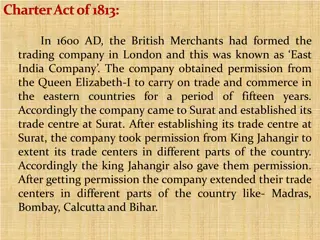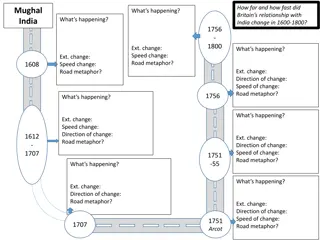Impacts of British Rule in India
Explore the historical journey of British colonialism in India through key events such as the expansion of the East India Company, cultural changes, imposition of British laws, the Sepoy Mutiny, and subsequent protests. Witness the transformation of Indian society and the rise of resistance against British rule during this significant period.
Download Presentation

Please find below an Image/Link to download the presentation.
The content on the website is provided AS IS for your information and personal use only. It may not be sold, licensed, or shared on other websites without obtaining consent from the author.If you encounter any issues during the download, it is possible that the publisher has removed the file from their server.
You are allowed to download the files provided on this website for personal or commercial use, subject to the condition that they are used lawfully. All files are the property of their respective owners.
The content on the website is provided AS IS for your information and personal use only. It may not be sold, licensed, or shared on other websites without obtaining consent from the author.
E N D
Presentation Transcript
BAJKUL MILANI MAHAVIDAYLAYA PRESENTED BY UTTAM DAS SACT-I DEPARTMENT OF HISTORY ( UG& PG)
The British Empire in India SESSION-2018-2019 PG-3rdSEM PAPER-302 UNIT-I
India in the 18th and early 19th Century
East India Company 1600 East India Company activity limited to coastal trading cities when the Mughal Empire was strong . In the mid-1700s, the Mughal Empire broke apart . East India Company leaders saw chance to take over Indian lands.
Changes in India East India Company made changes to Indian society 1.English language. 2.British also invited Christian missionaries to spread beliefs.
Changes in India Banning customs. Straining relations. introduced British laws banning certain customs, such as sati . Practice of Hindu widows throwing selves on husbands funeral fires. Straining relations. Allowed Indian princes to rule under the supervision of British overlord Sent a dual message to the Indian People-preserve cultural heritage but conform to British customs and beliefs
Sepoys were Indian soldiers who fought in the British army. The Sepoy Mutiny In 1857, strained relations exploded into rebellion.
The Sepoy Mutiny Introduction of new type British rifle set off rebellion To load the rifle, soldier had to bite off the end of an ammunition cartridge greased with pork and beef fat. This offended Muslim and Hindu sepoys Muslims did not eat pork. Hindus did not eat beef.
Protest and Punishment during the Sepoy Mutiny Sepoys in Meerut refused to use cartridge . Thought that it was a plot to make them abandon Hinduism and Islam. Sepoys punished for protesting. In response, northern Indian sepoys rose up against British. Eventually gained control of Delhi.
Violence of the Sepoy Mutiny Violence of rebellion horrific Both sides committed atrocities . Sepoys killed British officers, as well as women and children . Captured mutineers were strapped to cannons and shot . Villages were burned . Fighting continued two years.
Results of the Sepoy Mutiny British ended the rule of East India Company in 1858.British government ruled India directly. British moved away from some social regulations that angered many Indians. Distrust still continued between British and Indians.
India as a British Colony Considered the jewel in the crown of the British Empire Created political and financial rewards, as well as British national pride. For Indians, British rule was a source of frustration and humiliation. Frustration gave rise to powerful feelings of nationalism. Westernization. Many British thought they were superior. Segregated neighborhoods and exclusive clubs. Westernized Indians. Prejudiced. Thought Indians incapable of governing themselves.
The Raj and the ICS Era of British rule in India often called British Raj . Hindi word meaning rule . Administration carried out by government agency. Indian Civil Service (ICS). Though ruling India, most ICS officials were British. ICS employed very few Indians. Many educated Indians frustrated at having no say in its own government.
Life under the British Raj Building Projects Built railroads, roads, and canals . By 1910, India had the fourth largest railroad network in the world. British invested in transportation to move troops. Helped sell British products.
Life under the British Raj Commerce India was a very important market for British manufactured goods. India was a source of raw materials Especially cotton, tea, indigo, and jute.
Life under the British Raj Impact of British Commerce British manufactured goods devastated India s pre- existing textile industry. Had been major exporter. British closed factories to prevent competition. By the mid-1800s, India primary exported raw materials, not manufactured goods.























